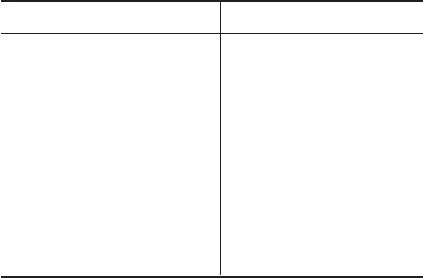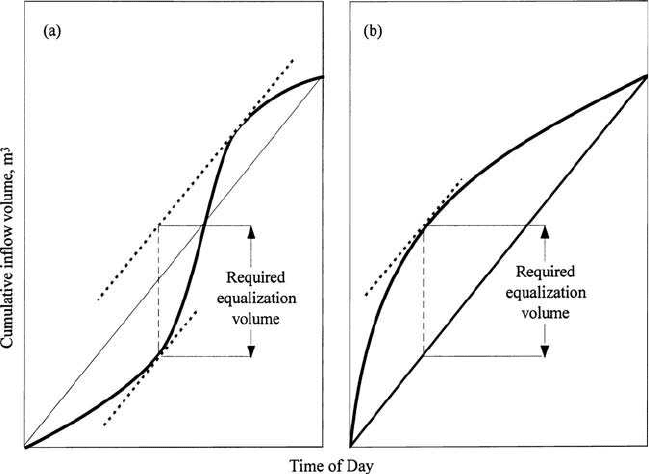Lin S.D. Water and Wastewater Calculations Manual
Подождите немного. Документ загружается.


⫽ 1.83 ⫻ 1 ⫻ [(0.9 m/s)
2
/(2 ⫻ 9.81 m)] ⫻ 0.866
⫽ 0.065 m
Note: If we want to calculate the headloss through the rack at 50% clog-
ging, many engineers use an approximate method. When the rack becomes
half-plugged, the area of the flow is reduced to one half, and velocity
through the rack is doubled. Thus the headloss will be 0.260 m (four times
0.065 m).
14.2 Fine screens
Fine screens are used more frequently in wastewater treatment plants
for preliminary treatment or preliminary/primary treatment purposes.
Fine screens typically consist of wedge-wire, perforated plate, or closely
spaced bars with openings 1.5 to 6.4 mm (0.06 to 0.25 in). Fine screens
used for preliminary treatment are rotary or stationary-type units
(US EPA 1987a).
The clean water headloss through fine screens may be obtained from
manufacturers’ rating tables, or may be computed by means of the
common orifice equation
(6.32)
where h ⫽ headloss, m or ft
v ⫽ approach velocity, m/s or ft/s
C ⫽ coefficient of discharge for the screen
g ⫽ gravitational acceleration, m/s
2
or ft/s
2
Q ⫽ discharge through the screen, m
3
/s or ft
3
/s
A ⫽ area of effective opening of submerged screen, m
2
or ft
2
Values of C depend on the size and milling of slots, the diameter and
weave of the wire, and the percentage of open area. They must be deter-
mined experimentally. A typical value of C for a clean screen is 0.60. The
headloss of clean water through a clean screen is relatively less.
However, the headloss of wastewater through a fine screen during oper-
ation depends on the method and frequency of cleaning, the size and
quantity of suspended solids in the wastewater, and the size of the
screen opening.
The quantity of screenings generated at wastewater treatment plants
varies with the bar opening, type of screen, wastewater flow, charac-
teristics of served communities, and type of collection system. Roughly,
h 5
1
2g
a
v
C
b
2
5
1
2
a
Q
CA
b
2
H 5 Ba
v
b
b
4/3
v
2
2g
sin u
Wastewater Engineering 585
3.5 to 35 L (0.93–9.25 gal) of screenings is produced from 1000 m
3
(264, 200 gal) wastewater treated. Screenings are normally 10% to 20%
dry solids, with bulk density of 640 to 1120 kg/m
3
(40 to 70 lb/ft
3
) (WEF
and ASCE, 1991a).
15 Comminutors
As an alternative to racks or screens, a comminutor or shredder cuts and
grinds up the coarse solids in the wastewater to about 6 to 10 mm (1/4
to 3/8 in) so that the solids will not harm subsequent treatment equip-
ment. The chopped or ground solids are then removed in primary sedi-
mentation basins. A comminutor consists of a fixed screen and a moving
cutter. Comminution can eliminate the messy and offensive screenings
for solids handling and disposal. However, rags and large objects cause
clogging problems.
Comminutors are installed directly in the wastewater flow channel
and are equipped with a bypass so that the unit can be isolated for serv-
ice maintenance. The sizes, installations, operation, and maintenance
of the comminutors are available from the manufactures.
16 Grit Chamber
Grit originates from domestic wastes, stormwater runoff, industrial
wastes, pumpage from excavations, and groundwater seepage. It con-
sists of inert inorganic material such as sand, cinders, rocks, gravel,
cigarette filter tips, metal fragments, etc. In addition grit includes
bone chips, eggshells, coffee grounds, seeds, and large food wastes
(organic particles). These substances can promote excessive wear of
mechanical equipment and sludge pumps, and even clog pipes by
deposition.
Composition of grit varies widely, with moisture content ranging from
13% to 63%, and volatile content ranging from 1% to 56%. The specific
gravity of clean grit particles may be as high as 2.7 with inert material,
and as low as 1.3 when substantial organic matter is agglomerated with
inert. The bulk density of grit is about 1600 kg/m
3
or 100 lb/ft
3
(Metcalf
and Eddy, Inc. 1991).
Grit chambers should be provided for all wastewater treatment plants,
and are used on systems required for plants receiving sewage from com-
bined sewers or from sewer systems receiving a substantial amount of
ground garbage or grit. Grit chambers are usually installed ahead of
pumps and comminuting devices.
Grit chambers for plants treating wastewater from combined sewers
usually have at least two hand cleaned units, or a mechanically cleaned
unit with bypass. There are three types of grit settling chamber: hand
586 Chapter 6
cleaned, mechanically cleaned, and aerated or vortex-type degritting
units. The chambers can be square, rectangular, or circular. A velocity
of 0.3 m/s (1 ft/s) is commonly used to separate grit from the organic
material. Typically, 0.0005 to 0.00236 m
3
/s (1 to 5 ft
3
/min) of air per foot
of chamber length is required for a proper aerated grit chamber; or 4.6
to 7.7 L/s per meter of length. The transverse velocity at the surface
should be 0.6 to 0.8 m/s or 2 to 2.5 ft/s (WEF, 1996a).
Grit chambers are commonly constructed as fairly shallow longitu-
dinal channels to catch high specific gravity grit (1.65). The units are
designed to maintain a velocity close to 0.3 m/s (1.0 ft/s) and to pro-
vide sufficient time for the grit particle to settle to the bottom of the
chamber.
Example: The designed hourly average flow of a municipal wastewater
plant is 0.438 m
3
/s (10 Mgal/d). Design an aerated grit chamber where the
detention time of the peak flow rate is 4.0 min (generally 3 to 5 min).
solution:
Step 1. Determine the peak hourly flow Q
Using a peaking factor of 3.0
Step 2. Calculate the volume of the grit chamber
Two chambers will be used; thus, for each unit
Volume ⫽ 1.314 m
3
/s ⫻ 4 min ⫻ 60 s/min ⫼ 2
⫽ 157.7 m
3
⫽ 5570 ft
3
Step 3. Determine the size of a rectangular chamber
Select the width of 3 m (10 ft), and use a depth-to-width ratio of 1.5:1 (typi-
cally 1.5:1 to 2.0:1)
Depth ⫽ 3 m ⫻ 1.5 ⫽ 4.5 m
⫽ 15 ft
Length ⫽ volume/(depth ⫻ width) ⫽ 157.7 m
3
/(4.5 m ⫻ 3m)
⫽ 11.7 m
⫽ 36 ft
5 30 Mgal/d
5 1.314 m
3
/s
Q 5 0.438 m
3
/s 3 3
Wastewater Engineering 587
Note: Each of the two chambers has a size of 3 m ⫻ 4.5 m ⫻ 11.7 m or
10 ft ⫻ 15 ft ⫻ 36 ft.
Step 4. Compute the air supply needed
Use 5 std ft
3
/min (scfm) or (0.00236 m
3
/s per ft (0.3 m) length.
Air needed ⫽ 0.00236 m
3
/(s ⭈ ft) ⫻ 36 ft
⫽ 0.085 m
3
/s
or ⫽ 5 ft
3
/min ⭈ ft ⫻ 36 ft
⫽ 180 ft
3
/min
Step 5. Estimate the average volume of grit produced
Assume 52.4 mL/m
3
(7 ft
3
/Mgal) of grit produced
Volume of grit ⫽ 52.4 mL/m
3
⫻ 0.438 m
3
/s ⫻ 86,400 s/d
⫽ 1,980,000 mL/d
⫽ 1.98 m
3
/d
or ⫽ 7 ft
3
/Mgal ⫻ 10 Mgal/d
⫽ 70 ft
3
/d
17 Flow Equalization
The Parshall flume is commonly used in wastewater treatment plants.
Methods of flow measurement are discussed in Chapter 4.
The incoming raw wastewater varies with the time of the day, the so-
called diurnal variation, ranging from less than one half to more than
200% of the average flow rate. A storm event increases the flow. Flow
equalization is used to reduce the sudden increase of inflow and to bal-
ance the fluctuations in the collection system or in the in-plant storage
basins. This benefits the performance of the downstream treatment
processes and reduces the size and cost of treatment units.
Flow equalization facilities include the temporary storage of flows in
existing sewers, the use of in-line or on-line separate flow-equalization
facilities or retention basins.
The volume for a flow equalization basin is determined from mass dia-
grams based on average diurnal flow patterns.
Example: Determine a flow equalization basin using the following diurnal
flow record:
588 Chapter 6

solution 1:
Step 1. Compute the average flow rate Q
Step 2. Compare the observed flows and average flow from the data shown
above
The first observed flow to exceed Q is at 8 a.m.
Step 3. Construct a table which is arranged in order, beginning at 8 a.m.
See Table 6.8. Calculations of columns 3 to 6 are given in the following steps.
Step 4. For col. 3, convert the flows to volume for 1 h time interval
Volume ⫽ 0.072 m
3
/s ⫻ 1 h ⫻ 3600 s/h
⫽ 259.2 m
3
Step 5. For col. 4, for each row, calculate average volume to be treated
Volume ⫽ Q ⫻ 1 h ⫻ 3600 s/h
⫽ 0.0655 m
3
/s ⫻ 1 h ⫻ 3600 s/h
⫽ 235.8 m
3
Step 6. For col. 5, calculate the excess volume needed to be stored
col. 5 ⫽ col. 3 ⫺ col. 4
Example: 259.2 m
3
⫺ 235.8 m
3
⫽ 23.4 m
3
Step 7. For col. 6, calculate the cumulative sum of the difference (col. 5)
Q 5
⌺
q/24 5 0.0655 m
3
/s
Time Flow, m
3
/s Time Flow, m
3
/s
Midnight 0.0492 Noon 0.1033
1 0.0401 1 p.m. 0.0975
2 0.0345 2 0.0889
3 0.0296 3 0.0810
4 0.0288 4 0.0777
5 0.0312 5 0.0755
6 0.0375 6 0.0740
7 0.0545 7 0.0700
8 0.0720 8 0.0688
9 0.0886 9 0.0644
10 0.0972 10 0.0542
11 0.1022 11 0.0513
Wastewater Engineering 589

Example: For the second time interval, the cumulative storage (cs) is
cs ⫽ 23.4 m
3
⫹ 83.16 m
3
⫽ 106.56 m
3
Note: The last value for the cumulative storage should be zero. Theoretically,
it means that the flow equalization basin is empty and ready to begin the next
day’s cycle.
Step 8. Find the required volume for the basin
The required volume for the flow equalization basin for this day is the
maximum cumulative storage. In this case, it is 882.72 m
3
at 8 p.m.
(col. 6, Table 6.8). However, it is common to provide 20% to 50% excess
capacity for unexpected flow variations, equipment, and solids deposition.
In this case, we provide 35% excess capacity. Thus the total storage volume
should be
Total basin volume ⫽ 882.72 m
3
⫻ 1.35
⫽ 1192 m
3
590 Chapter 6
TABLE 6.8 Analysis of Flow Equalization
(1) (2) (3) (4) (5) (6)
Time Flow Volume in, Volume out, Storage ⌺ storage,
m
3
/s m
3
m
3
m
3
m
3
8 a.m. 0.072 259.2 235.8 23.4 23.4
9 0.0886 318.96 235.8 83.16 106.56
10 0.0972 349.92 235.8 114.12 220.68
11 0.1022 367.92 235.8 132.12 352.8
12 0.1033 371.88 235.8 136.08 488.88
1 p.m. 0.0975 351 235.8 115.2 604.08
2 0.0889 320.04 235.8 84.24 688.32
3 0.081 291.6 235.8 55.8 744.12
4 0.0777 279.72 235.8 43.92 788.04
5 0.0755 271.8 235.8 36 824.04
6 0.0740 266.4 235.8 30.6 854.64
7 0.0700 252 235.8 16.2 870.84
8 0.0688 247.68 235.8 11.88 882.72
9 0.0644 231.84 235.8 –3.96 878.76
10 0.0542 195.12 235.8 –40.68 838.08
11 0.0513 184.68 235.8 –51.12 786.96
12 0.0492 177.12 235.8 –58.68 728.28
1 a.m. 0.0401 144.36 235.8 –91.44 636.84
2 0.0345 124.2 235.8 –111.6 525.24
3 0.0296 106.56 235.8 –129.24 396
4 0.0288 103.68 235.8 –132.12 263.88
5 0.0312 112.32 235.8 123.48 140.4
6 0.0375 135 235.8 –100.8 39.6
7 0.0545 196.2 235.8 –39.6 0

solution 2: Graphic method (Fig. 6.5).
Step 1. Calculate cumulative volumes as in solution 1
Step 2. Plot time of day at X-axis (starting at midnight) versus cumulative
volume at Y-axis to produce a mass curve
Step 3. Connect the origin and the final point on the mass curve
This gives the daily average flow rate (m
3
/d or Mgal/d).
Step 4. Draw two lines parallel to the average flow rate and tangent to the
mass curve at the highest and lowest points
Step 5. Determine the required volume for the flow equalization basin
The vertical distance between two parallels drawn in Step 4 is the required
basin capacity.
Note: In the above example, the storage starts to fill in at 8 a.m. and it is empty
24 h later. At the highest point of the cumulative volume draw a tangent line
(Fig. 6.5b). The distance between this tangent line and the average flow line is
the storage volume required.
Wastewater Engineering 591
Figure 6.5 Mass diagram for determining required equalization volume.

18 Sedimentation
Sedimentation is the process of removing solid particles heavier than
water by gravity settling. It is the oldest and most widely used unit oper-
ation in water and wastewater treatments. The terms sedimentation,
settling, and clarification are used interchangeably. The unit sedimen-
tation basin may also be referred to as a sedimentation tank, clarifier,
settling basin, or settling tank.
In wastewater treatment, sedimentation is used to remove both inor-
ganic and organic materials which are settleable in continuous-flow con-
ditions. It removes grit, particulate matter in the primary settling tank,
and chemical flocs from a chemical precipitation unit. Sedimentation is
also used for solids concentration in sludge thickeners.
Based on the solids concentration, and the tendency of particle inter-
action, there are four types of settling which may occur in waste-water set-
tling operations. The four categories are discrete, flocculant, hindered
(also called zone), and compression settlings. They are also known as types
1, 2, 3, and 4 sedimentation, respectively. Some discussion of sedimenta-
tion is covered in Chapter 5. The following describes each type of settling.
18.1 Discrete particle sedimentation (type 1)
The plain sedimentation of a discrete spherical particle, described by
Newton’s law, can be applied to grit removal in grit chambers and sed-
imentation tanks. The terminal settling velocity is determined as (also
in Chapter 5, Eq. (5.60))
(6.33)
where v
s
⫽ terminal settling velocity, m/s or ft/s
r
s
⫽ mass density of particle, kg/m
3
or lb/ft
3
r ⫽ mass density of fluid, kg/m
3
or lb/ft
3
g ⫽ acceleration due to gravitation, 9.81 m/s
2
or 32.2 ft/s
2
d ⫽ diameter of particle, mm or in
C
D
⫽ dimensionless drag coefficient
The drag coefficient C
D
is not constant. It varies with the Reynolds
number and the shape of the particle. The Reynolds number R ⫽ vdr/m,
where m is the absolute viscosity of the fluid, and the other terms are
defined as above.
C
D
varies with the effective resistance area per unit volume and shape
of the particle. The relationship between R and C
D
is as follows
(6.34)
1. R: C
D
5
24
R
5
24m
vrd
v
s
5 c
4gsr
s
2 rdd
3C
Dr
d
1/2
592 Chapter 6

(6.35)
(6.36)
(6.37)
For small R (⬍1 or 2) with laminar flow. Equation (6.34) is applied.
Equation (6.35) or (6.36) is applicable for R up to 1000, which includes
all situations of water and wastewater treatment processes. For fully
developed turbulent settling use C
D
⫽ 0.34 to 0.40 (Eq. (6.37)).
When the Reynolds number is less than 1, substitution of Eq. (6.34)
for C
D
in Eq. (6.33) yields Stoke’s law (Eq. (5.63))
(6.38)
Discrete particle settling refers to type 1 sedimentation. Under qui-
escent conditions, suspended particles in water or wastewater exhibit
a natural tendency to agglomerate, or the addition of coagulant chem-
icals promotes flocculation. The phenomenon is called flocculation–
sedimentation or type 2 sedimentation. For flocculated particles the
principles of settling are the same as for a discrete particle, but settling
merely occurs at a faster rate.
18.2 Scour
The horizontal velocity in grit chambers or in sedimentation tanks must
be controlled to a value less than what would carry the particles in trac-
tion along the bottom. The horizontal velocity of fluid flow just sufficient
to create scour is described as (Camp, 1946)
(6.39)
where V ⫽ horizontal velocity, m/s
b ⫽ constant for the type of scoured particles
⫽ 0.04 for unigranular material
⫽ 0.06 for sticky interlocking material
s ⫽ specific gravity of particle
g ⫽ acceleration due to gravity, 9.81 m/s
2
d ⫽ diameter of particle, m
f ⫽ Darcy–Weisbach friction factor, 0.02 to 0.03
V 5 c
8bss 2 1dgd
f
d
1/2
v
s
5
gsr
s
2 rdd
2
18m
R .1000: C
D
5 0.34 to 0.40
or 5
18.5
R
0.5
1 , R ,1000: C
D
5
24
R
1
3
R
0.5
1 0.34
Wastewater Engineering 593

The f values are a function of the Reynolds number and surface char-
acteristics of the settled solids. The horizontal velocity in most sedi-
mentation tanks is well below that which would cause scour. In grit
chambers, scour is an important factor for design.
Example: Determine the surface overflow rate and horizontal velocity of a
grit chamber to remove the grit without removing organic material. Assume
that grit particles have a diameter of 0.2 mm (0.01 in) and a specific gravity
of 2.65 (sand, silt, and clay); and organic material has the same diameter and
a specific gravity of 1.20. Assume C
D
⫽ 10.
solution:
Step 1. Compute the terminal settling velocity, using Eq. (6.33)
C
D
⫽ 10
d ⫽ 0.2 mm ⫽ 0.02 cm
v
s
⫽
⫽
⫽
Note: This will be the surface overflow rate to settle grit, not organic matter.
Step 2. Compute the horizontal velocity (V
1
) just sufficient to cause the grit
particles to scour
Use b ⫽ 0.06 and f ⫽ 0.03. Using Eq. (6.39)
Step 3. Compute the scouring velocity V
2
for organic material, using
Eq. (6.39)
5 7.9 scm/sd
V
2
5 c
8 3 0.06s1.20 2 1d 3 981 3 0.02
0.03
d
1/2
5 22.8 scm/sd
5 c
8 3 0.06 3 s2.65 2 1d 3 981 3 0.02
0.03
d
1/2
V
1
5 c
8bss 2 1dgd
f
d
1/2
2.08 scm/sd
c
4 3 981 3 s2.65 2 1d 3 0.02
3 3 10 3 1
d
1/2
c
4gsr
s
2 rdd
3C
D
r
d
1/2
594 Chapter 6
